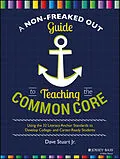Implement the Common Core for ELA without all the stress
A Non-Freaked Out Guide to Teaching the Common Core uses
the often-neglected anchor standards to get to the heart of the
Common Core State Standards (CCSS)--teaching students the
skills they need to be college and career ready. Each anchor
standard is broken down into its key points, and a discussion of
each anchor standard's central purpose helps outline the context
for each required skill. This easy-to-read guide gives educators
the kind of clear explanations, examples, and strategies they need
to feel comfortable teaching the CCSS, and shows how CCSS skills
can be integrated into virtually any existing lesson plan.
Getting a firm grasp of the anchor standards is the quickest way
to start teaching the key concepts of the CCSS, and this
user-friendly guide is designed to pave the way for both the
first-time teacher and the experienced pro.
Autorentext
DAVE STUART JR. teaches English and world history in Cedar Springs, Michigan. He also writes a popular blog on teaching the Common Core State Standards, called Teaching the Core (www.teachingthecore.com). With over ten thousand monthly readers, Dave's blog has been a beacon of light for teachers who refuse to freak out about the Common Core. He also speaks and gives workshops on literacy instruction, and he has served as an adjunct professor at Aquinas College.
Zusammenfassung
Implement the Common Core for ELA without all the stress
A Non-Freaked Out Guide to Teaching the Common Core uses the often-neglected anchor standards to get to the heart of the Common Core State Standards (CCSS)teaching students the skills they need to be college and career ready. Each anchor standard is broken down into its key points, and a discussion of each anchor standard's central purpose helps outline the context for each required skill. This easy-to-read guide gives educators the kind of clear explanations, examples, and strategies they need to feel comfortable teaching the CCSS, and shows how CCSS skills can be integrated into virtually any existing lesson plan.
Getting a firm grasp of the anchor standards is the quickest way to start teaching the key concepts of the CCSS, and this user-friendly guide is designed to pave the way for both the first-time teacher and the experienced pro.
Inhalt
Preface xiii
Acknowledgments xv
About the Author xix
Introduction 1
An Epic Journey Beckons 1
A Sword for Your Quest 2
This Book Is Like a Taco 3
A Final Note before Diving In 5
PART I: FOUNDATIONS
CHAPTER 1: What Is the Central, Burning Question of the Common Core State Standards? 9
What's an Anchor Standard? 10
Why Call Them Anchors? 11
Why Not Just Use the Grade-Specific Standards? 11
CHAPTER 2: The Common Core's Broadest Answer to Its Central, Burning Question 13
Demonstrate Independence 14
Build Strong Content Knowledge 14
Respond to Task, Audience, Purpose, and Discipline 15
Comprehend as Well as Critique 15
Value Evidence 16
Use Technology Strategically and Capably 16
Come to Understand Other Perspectives and Cultures 17
PART II: THE ANCHOR STANDARDS IN READING RCCR1 21
Read Closely 21
Determine Literal, Explicit Meaning 23
Make Logical Inferences 23
Support Conclusions with Textual Evidence 24
RCCR2 26
Decide on What's Central 26
Pull Apart How That Central Thing Is Developed 27
Summarize the Text 28
RCCR3 30
How Do Individuals, Events, or Ideas Develop and Interact over the Course of a Text? 30
Why Do Individuals, Events, or Ideas Develop and Interact over the Course of a Text? 31
RCCR4 33
Interpret Words and Phrases 33
Analyze Word Choice 35
RCCR5 38
Structure and Interconnectedness in Novels 38
Structure and Interconnectedness in Articles 39
Structure and Interconnectedness in Poems 40
Structure and Interconnectedness in Primary Source Documents 41
Structure and Interconnectedness in Textbooks 42
RCCR6 43
Point of View 43
Purpose 44
How Do Point of View and Purpose Shape Literary Texts? 44
How Do Point of View and Purpose Shape an Informational Text? 45
RCCR7 47
Evaluate Content 47
Evaluate Diverse Content 48
Integrate It All 49
RCCR8 51
Delineating an Argument: Four Key Parts 51
Evaluating an Argument 52
RCCR9 54
Read Related Texts 54
Read Related Texts to Build Knowledge 55
Read Related Texts to Compare Authorial Approaches 56
RCCR10 57
Read and Comprehend Grade-Appropriate Complex Texts 57
Profi ciently Read Both Informational and Literary Texts 62
PART III: THE ANCHOR STANDARDS IN WRITING WCCR1 67
Why Is Argumentative Writing First? 67
So, What's an Argument, According to the Common Core? 68
Make a Claim about a Substantive Topic or Text 69
Support That Claim with Relevant and Sufficient Evidence 70
Tie It All Together with Valid Reasoning 71
WCCR2 75
How Does the Common Core Defi ne Informative/Explanatory Texts? 75
What Genres Fall under the Umbrella Genre of Informative/Explanatory Writing? 76
How Does Informative/Explanatory Writing Differ from Argumentative Writing? 77
Select, Organize, and Analyze Content 78
Maintain Accuracy and Clarity 78
WCCR3 80
How Does the Common Core Define Narrative Writing? 80
Develop Real or Imagined Experiences 81
Use Well-Chosen Details 81
Use Well-Structured Event Sequences 82
Use Effective Technique 82
How Should the Three Common Core Modes of Writing Be Balanced? 82
WCCR4 85
Task 85
Audience 86
Purpose 86
WCCR5 88
The Not-So-Sexy Parts of the Writing Process 88
Plan 88
Revise 89
Edit 90
Rewrite or Try a New Approach 90
WCCR6 92
We Bought iPads, and Now...
